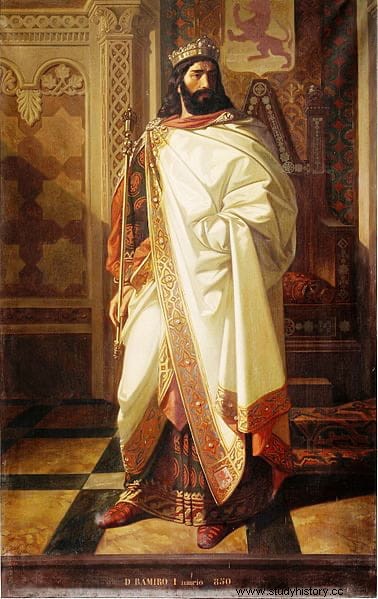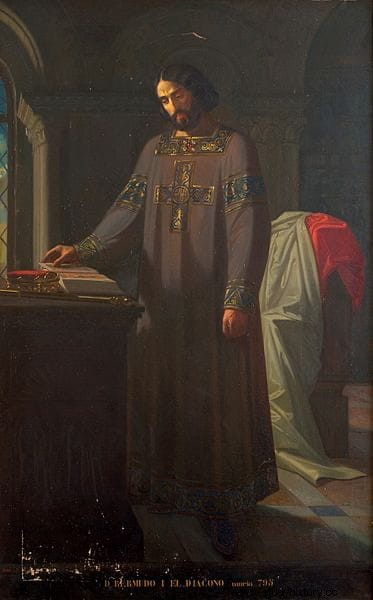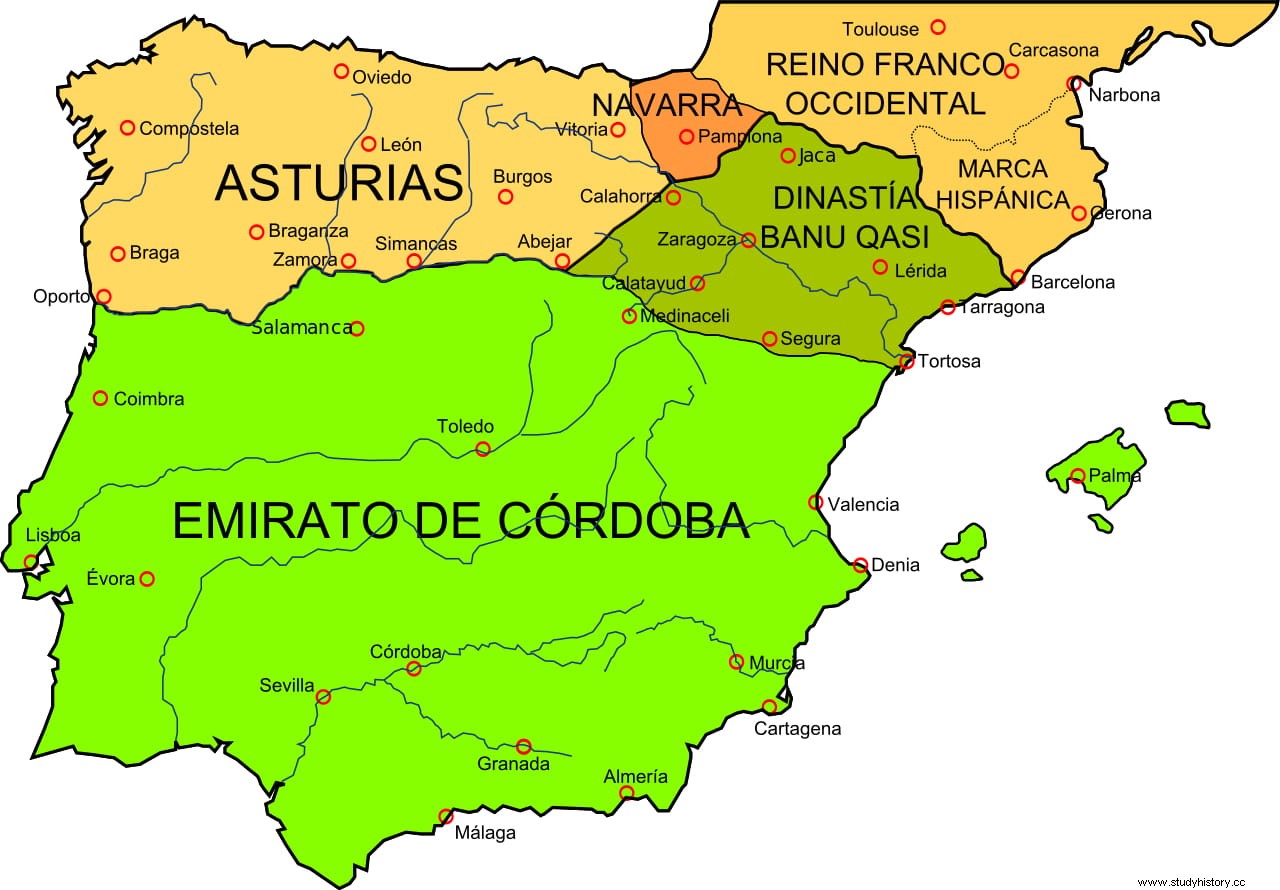Some time ago we dedicated a few articles to analyze the real life of the characters of the television series Vikings . One of them was Björn Ragnarsson, son of Ragnar Lodbrok, who was part of an incursion around the Mediterranean with a first episode in Santiago de Compostela. The chronicles of the time narrate that the person responsible for putting them to flight, on behalf of King Ordoño I, was an Asturgalaic knight named Pedro Theon, possibly of royal blood, who was also accompanied by his offspring, Vimara Pérez. The latter is traditionally considered one of the founders of Portugal.
Let's start with the Vikings. It was not the first time that they camped on the Iberian Peninsula. Fourteen years earlier, in 844 AD, they had carried out a first expedition whose first landing point on the Iberian Peninsula was Gijón. A very short time, yes, which leads us to suppose that perhaps they limited themselves to provisioning (perhaps after an agreement with the local inhabitants), to re-embark and set sail for Coruña. In any case, the people of Gijon sent a messenger to neighboring Oviedo to warn King Ramiro I, who sent troops to the Galician city and joined the local troops of the Erice brothers, confronting the intruders.

Ramiro was the twelfth of the Asturian dynasty and was responsible for the construction of some of the most emblematic monuments of pre-Romanesque art (such as the churches of Santa Cristina de Lena, San Miguel de Lillo and, above all, the iconic Santa María del Naranco, which was then it was a palatial royal classroom). The chronicles of bishops Rodrigo Jiménez de Rada and Lucas de Tuy tell succinctly how it all ended:«And so it happened there that King Don Ramiro defeated and defeated them, and then ordered the fleet to be set on fire and burned LXX ships » .
Likewise, the Rotense Chronicle , written in the 10th century, reviews the arrival of those “Normans, a hitherto unknown, pagan and very cruel people” , who finally, after suffering heavy casualties in Santa María de Camporramiro, got back on his drakkars . The Viking squad continued their journey towards Usbuna (Lisbon), one of the richest cities in the Emirate of Córdoba, which also managed to resist. But the majus , as the Muslims called the pagans, continued towards the south and the Andalusian Atlantic coast, then going up the Guadalquivir to go to Seville.

Finally, Abderramán II defeated them in Talyata (Italica) and killed a good number of them, allowing the rest to leave in exchange for the return of the loot. Works such as the History of the conquest of al-Andalus testify to everything. (by Abu Bakr), the Book of the amazing history of the kings of al-Andalus (from Ibn Idhari) and Maghreb or The maximum ambition in the arts of scholarship (by Al-Nuwayri), although they are much later than the events:the first two from the 10th century and the third from the 16th.
Despite having managed to put the Vikings to flight, both Christians and Muslims took good note of the danger and fortified their coasts with towers and other defensive systems, of which the best example survives in Seville:the Reales Alcázares. Horseback messenger services were also created to notify when sails were visible on the horizon. And, indeed, those sails reappeared again in the year 858. Specifically, those of sixty-two ships.
The existence of the Camino de Santiago and the riches that were linked to it, made Björn and his brother Hastein lead an expedition to Jacobslan (Jacob's Land, that is, Galicia) as the first objective. They landed in the Arosa estuary and after roaming freely through Iria Flavia, they surrounded Santiago de Compostela. The city resisted for two weeks, but since it hardly had any walls, the fall seemed imminent, so the payment of a danegeld was agreed upon. (a tax that the Vikings proposed in exchange for retiring). However, they did not fulfill the agreement and once they were paid, they resumed the siege.

The situation was already extreme when an unexpected solution arrived:the appearance of Pedro Theon, Count of Pravia, commanding together with Vimara the army that King Ordoño I, the son and successor of Ramiro I, sent to the aid of those lands of his kingdom. . That surprise force dissuaded the assailants from continuing; since they already had the danegeld , it was not convenient to get bogged down in a long battle that could cost them too many casualties, so they got on their ships and headed for the Mediterranean. The Albeldense Chronicle describes the clash, if there was one, briefly and simply:“At that time the Normans came again to the shores of Galicia, where they were defeated by Count Pedro” .
The sources say that Peter Theon destroyed thirty-eight ships against them; Now, who was this character? Like almost everything related to the Middle Ages, the data is uncertain. The possibility that he was the son of Bermudo I, who reigned in Asturias for three years (between 789 and 791), after Mauregato, has been suggested. This was an illegitimate son that Alfonso I had with a Muslim slave and had ascended to the throne after deposing Alfonso II.
Alfonso II was a promoter of the arts and even maintained diplomatic relations with Charlemagne, but he did not have much support among the Asturian nobles because he was the son of Fruela I, whom he had nicknamed the Cruel for obvious reasons. In addition, nobility pressures increased due to what was considered the need for a strong monarch to face the Muslims, hence the support they gave Mauregato. But, finally, Bermudo returned the crown to Alfonso and took the robes - hence the nickname of the Deacon -.

Alfonso II died in the year 842, leaving an illustrious reign, although without descendants (that is why he also had his nickname, the Chaste ). The chosen substitute was a son of Bermudo, Ramiro I, whom we mentioned earlier as responsible for coming to the aid of Santiago de Compostela, although one theory points to the possibility that Ramiro was not really his descendant but of another Bermudo. Nor is there any documentary source that credits Pedro Theon as a scion of the king and his wife, Ozenda, so everything remains in the realm of probable speculation.
Years after his intervention against the Vikings, Pedro Theon would join the Curia Regia (something like the royal council) of Alfonso III, a sovereign to whom he remained faithful in the face of the insurrection of Fruela Bermúdez, who proclaimed himself king in Oviedo in the 866 although it ended defeated. In the donation letter with which Alfonso III returns the town of Carcacía to the Compostela Church, usurped by the rebel, Pedro Theon appears as signatory; his name appears without any accompanying title, which raises doubts about the county of Pravia attributed to him.
It is not the only uncertainty, as we are seeing. The date of his death and the place where he is buried are also unknown. Likewise, there is no shortage of problems with the offspring he had. His son and born, apparently in Galicia, was Vimara Pérez, although it is not so clear if Hermenegildo Pérez should also be added, whose paternity is attributed to him simply by the patronymic, since no document has been preserved that endorses him. After the death of his presumed father, Hermenegildo would take up arms against Alfonso III around 886, being defeated and losing a good part of his possessions (perhaps also his life) in the attempt.

Instead, Vimara was faithful to his vassalage oath and, on behalf of the king, took part in numerous actions. At that stage, it was necessary to go beyond the Miño river, to conquer the Duero valley, a territory that is currently part of Portugal and was then in dispute with the Muslims, to make it a defensive buffer for the Asturian kingdom and repopulate it with Christians. In this process, the taking of Portu Cale (present-day Vila Nova de Gaia, a metropolitan area of Porto) in 868 earned him the first titleholder of the county of the same name, which was not only the city but everything that extended between the Limia and Duero rivers, and then expanded further south, surpassing the Mondego.
The County of Portucalense experienced a period of prosperity, extending the repopulation to the south of the Duero and encompassing cities such as Braga, Viseu, Lamego, Coimbra or Santa María da Feira; a bishopric was even established in Magneto (probably Meinedo). Vimara also founded a settlement to which he gave his own name, Vimaranis, which would eventually become Guimaraes. Tradition considers this town the cradle of Portugal, so that the count happens to be one of the promoters of the Portuguese country (which became independent from the Kingdom of León in the year 1143), something twice as the first Portuguese monarch, Alfonso I, would be from his dynasty.
The uncertainty that surrounds the figure of Pedro Theon can also be applied to Vimara Pérez. Although it is known that he married, no document has been preserved with the name of his wife, although many historians consider that she was a noblewoman named Trudildi; in such a case, both would have been parents of Auvidia Vimaraz, whom they would marry Count Gutierre Aloítez. Likewise, Vimara is attributed the paternity, also undocumented, of Lucidio Vimaranes, who was the successor of his father in the government of the Portucalense County from the year 873.

That would have been the date of Vimara Pérez's death, in a place called Vama. There were two sites with that name, one in Guimaraes and another in Galicia, not knowing which one it was; It is only known that Alfonso III had his court there at that time, who confirmed Lucidio as second count together with his butler, the Galician nobleman Hermenegildo Guitérrez; a distribution that probably obeyed the desire of the crown to put peace between the two. This was due to the fact that Hermenegildo was Lucidio's father-in-law, as he was married to his daughter, Gudilona Menéndez (who had four sisters -apart from two brothers-, one of whom, Elvira, would become queen consort of Galicia and León for her marriage to Ordoño II).
Paradoxically, it is speculated that it was probably Hermenegildo who ended the life of Vimara Pérez; maybe in some dispute for control of the region. After all, he had many possessions in it and its surroundings, since his wife's family owned the county of Gatón del Bierzo and he himself governed Coimbra, which had conquered the Muslims and whose territory, as was the case with the Portucalense, It covered much more than the city:from the Duero to the Mondego, so the jurisdiction in the area was close.

In any case, Vimara Pérez is remembered as one of the proto-founders of Portugal and, in fact, in 1968 the sculptor Salvador Barata Feyo was commissioned to create a bronze statue in his memory. It is placed in front of the Porto Cathedral, a city that has also dedicated a street to it.
